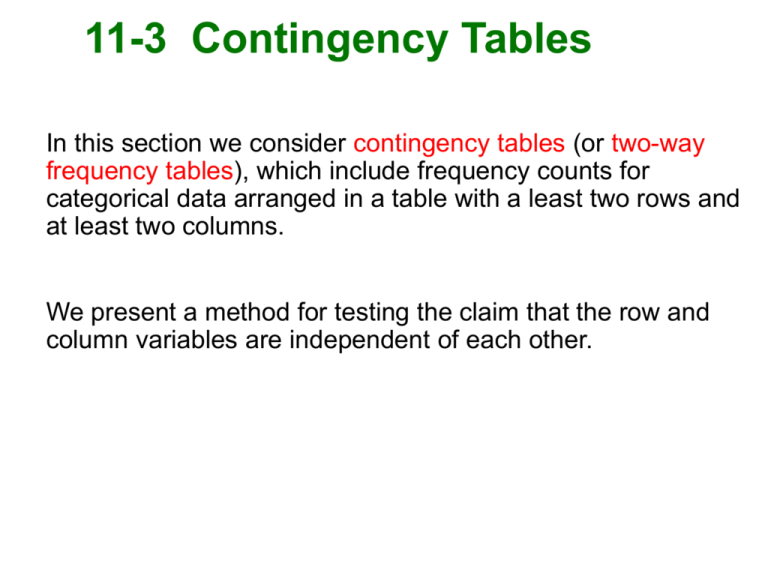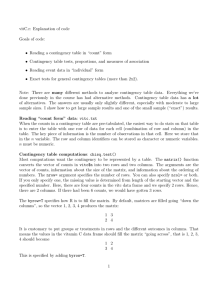Elementary Statistics 12e
advertisement

11-3 Contingency Tables In this section we consider contingency tables (or two-way frequency tables), which include frequency counts for categorical data arranged in a table with a least two rows and at least two columns. We present a method for testing the claim that the row and column variables are independent of each other. Basic Concepts of Testing for Independence A contingency table (or two-way frequency table) is a table in which frequencies correspond to two variables. (One variable is used to categorize rows, and a second variable is used to categorize columns.) Contingency tables have at least two rows and at least two columns. Example Below is a contingency table summarizing the results of foot procedures as a success or failure based different treatments. Definition Test of Independence A test of independence tests the null hypothesis that in a contingency table, the row and column variables are independent. Notation O represents the observed frequency in a cell of a contingency table. E represents the expected frequency in a cell, found by assuming that the row and column variables are independent r represents the number of rows in a contingency table (not including labels). c represents the number of columns in a contingency table (not including labels). Hypotheses and Test Statistic H 0 : The row and column variables are independent. H1 : The row and column variables are dependent. (O E ) E (row total)(column total) E (grand total) 2 2 O is the observed frequency in a cell and E is the expected frequency in a cell. Critical Values Critical Values 1. Found in Table A-4 using degrees of freedom = (r – 1)(c – 1) r is the number of rows and c is the number of columns 2. Tests of Independence are always right-tailed. Expected Frequencies Referring back to slide 3, the observed frequency is 54 successful surgeries. The expected frequency is calculated using the first row total of 66, the first column total of 182, and the grand total of 253. (row total)(column total) E (grand total) 66 182 47.478 253 Example Does it appear that the choice of treatment affects the success of the treatment for the foot procedures? Use a 0.05 level of significance to test the claim that success is independent of treatment group. Example - Continued Requirement Check: 1. Based on the study, we will treat the subjects as being randomly selected and randomly assigned to the different treatment groups. 2. The results are expressed in frequency counts. 3. The expected frequencies are all over 5. The requirements are all satisfied. Example - Continued The hypotheses are: H 0 : Success is independent of the treatment. H1 : Success and the treatment are dependent. The significance level is α = 0.05. Example - Continued We use a χ2 distribution with this test statistic: 2 O E E 58.393 2 54 47.478 47.478 2 5 6.174 6.174 2 Example - Continued Critical Value: The critical value of χ2 = 7.815 is found in Table A-4 with α = 0.05 and degrees of freedom of Because the test statistic does fall in the critical region, we reject the null hypothesis. r 1 c 1 4 1 2 1 3 A graphic of the chi-square distribution is on the next slide. Example - Continued Example - Continued Interpretation: It appears that success is dependent on the treatment. Although this test does not tell us which treatment is best, we can see that the success rates of 81.8%, 44.6%, 95.9%, and 77.3% suggest that the best treatment is to use a non-weight-bearing cast for 6 weeks. Relationships Among Key Components in Test of Independence






